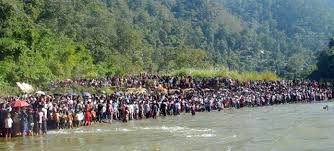The UN says there are now more refugees than at any time since 1994. Thousands of asylum-seekers, mainly from Afghanistan and the Middle East, head to Indonesia each year to make the dangerous voyage across the Indian ocean to Australia.
They are seeking a new life, fleeing war, political unrest, and poverty. The influx of asylum-seekers is a major political issue both in Indonesia and Australia, particularly as Indonesia has not signed up to the 1951 UN Refugee convention and does not have to accept refugees. Australia, on the other hand, is a signatory. The asylum-seekers pay thousands of dollars to people smugglers for a hazardous boat ride to Christmas Island. Many refugees from African countries such as Eritrea and Somalia have been paying people smugglers thousands of dollars to take them to Europe via the Mediterranean, often on rickety and crowded boats that sink in rough seas. On Sunday, Italian authorities intercepted 800 migrants trying to cross the Mediterranean as EU leaders met in Brussels to discuss the problem. The problem has attracted global attention after a series of accidents on the Mediterranean killed hundreds of migrants.
Fleeing Syrians
Officials say the new wave of migrants entering Europe has grown in size due to large numbers of people fleeing the Syrian civil war. Many of the migrants rescued recently when a boat carrying more than 250 passengers capsized were Syrians.
Italy and Malta, which are grappling with the flood of migrants, are at the forefront of the campaign to get European Union nations to deal with the influx. EU member states make a distinction between asylum seekers and refugees, with asylum seekers defined as people submitting a request for refugee status. The asylum seeker is not granted refugee status unless the member state decides they qualify, following a defined legal procedure.
More than 26 million people – 10.4 million refugees and 15.6 million IDPs – were receiving protection or assistance from UNHCR at the end of 2009.
This is 1 million more people than in 2008. By the end of 2009, UNHCR had identified up to 6.6 million stateless persons in 60 countries. However, the organisation estimated that the overall number of stateless persons worldwide could be far higher – about 12 million people. There are approximately 1.5 million recognised refugees living in the 27 member states of the EU plus Norway and Switzerland. This compares to a global figure of approximately 16 million.

